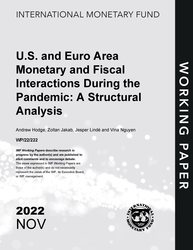
U.S. and Euro Area Monetary and Fiscal Interactions During the Pandemic: A Structural Analysis
U.S. and Euro Area Monetary and Fiscal Interactions During the Pandemic: A Structural Analysis
READ MORE...
Volume/Issue:
Volume 2022
Issue 222
Publication date: November 2022
ISBN: 9798400219818
$20.00
Add to Cart by clicking price of the language and format you'd like to purchase
Available Languages and Formats
| English |
Prices in red indicate formats that are not yet available but are forthcoming.
Topics covered in this book
This title contains information about the following subjects.
Click on a subject if you would like to see other titles with the same subjects.
Banks and Banking , Inflation , Economics- Macroeconomics , Money and Monetary Policy , Public Finance , Economics / General , Fiscal Policy , Monetary Policy , DSGE Model , inflation targeting in the U , S , , IMF working paper 22/222 , changes in the U , S , , Phillips curve , AIT gap , Inflation , Fiscal stimulus , Interest rate floor , Public investment spending , Central bank policy rate , Global , Western Hemisphere
Also of interest
Summary
This paper employs a two-country New Keynesian DSGE model to assess the macroeconomic impact of the changes in monetary policy frameworks and the fiscal support in the U.S. and euro area during the pandemic. Moving from a previous target of “below, but close to 2 percent” to a formal symmetric inflation targeting regime in the euro area or from flexible to average inflation targeting in the U.S. is shown to boost output and inflation in both regions. Meanwhile, the fiscal packages approved in the U.S. and the euro area, and a slower withdrawal of fiscal support in the euro area, have a similar impact on output and inflation as changing the monetary policy frameworks . Simultaneously implementing these policies is mutually reinforcing, but insufficient to fully explain the unexpected increase in core inflation during 2021.
Copyright © 2010 - 2025
Powered by:
AIDC



